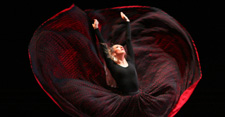MARTHA GRAHAM DANCE COMPANY ARTISTS
The Martha Graham Dance Company has been a leader in the development of contemporary dance since its founding in 1926. Informed by the expansive vision of pioneering choreographer Martha Graham, the Company brings to life a timeless and uniquely American style of dance that has influenced generations of artists and continues to captivate audiences. Graham and her Company have expanded contemporary dance’s vocabulary of movement and forever altered the scope of the art form by rooting works in contemporary social, political, psychological, and sexual contexts, deepening their impact and resonance.
Always a fertile ground for experimentation, Martha Graham Dance Company has been an unparalleled resource in nurturing many of the leading choreographers and dancers of the 20th and 21st centuries, including Merce Cunningham, Erick Hawkins, Pearl Lang, Pascal Rioult, and Paul Taylor. Graham’s repertoire of 181 works has also engaged noted performers such as Mikhail Baryshnikov, Claire Bloom, Margot Fonteyn, Liza Minnelli, Rudolf Nureyev, Maya Plisetskaya, and Kathleen Turner. Her groundbreaking techniques and unmistakable style have earned the Company acclaim from audiences in more than 50 countries throughout North and South America, Europe, Africa, Asia, and the Middle East.
Today, the Company continues to foster Graham’s spirit of ingenuity. It is embracing a new programming vision that showcases masterpieces by Graham, her contemporaries, and their successors alongside newly commissioned works by contemporary artists inspired by Graham’s legacy. With programs that unite the work of choreographers across time within a rich historical and thematic narrative, the Company is actively working to create new platforms for contemporary dance and multiple points of access for audiences.
About Martha Graham
Martha Graham’s revolutionary vision and artistic mastery has had a deep and lasting impact on American art and culture. Her bold use of socially infused subjects and emotionally charged performances single-handedly defined contemporary dance as a uniquely American art form, which the nation has in turn shared with the world.
Graham’s creativity crossed artistic boundaries and embraced every artistic genre. She collaborated with and commissioned work from the leading visual artists, musicians, and designers of her day, including sculptor Isamu Noguchi and fashion designers Halston, Donna Karan, and Calvin Klein, as well as composers Aaron Copland, Samuel Barber, William Schuman, Norman Dello Joio, and Gian Carlo Menotti.
Influencing generations of choreographers and dancers including Merce Cunningham, Paul Taylor, and Twyla Tharp, Graham forever altered the scope of dance. Classical ballet dancers Margot Fonteyn, Rudolf Nureyev, and Mikhail Baryshnikov sought her out to broaden their artistry, and artists of all genres were eager to study and work with Graham—she taught actors including Bette Davis, Kirk Douglas, Madonna, Liza Minelli, Gregory Peck, Tony Randall, Eli Wallach, Anne Jackson, and Joanne Woodward to utilize their bodies as expressive instruments.
Graham’s groundbreaking style grew from her experimentation with the elemental movements of contraction and release. By focusing on the basic activities of the human form, she enlivened the body with raw, electric emotion. The sharp, angular, and direct movements of her technique were a dramatic departure from the predominant style of the time.
With an artistic practice deeply ingrained in the rhythm of American life and the struggles of the individual, Graham brought a distinctly American sensibility to every theme she explored. “A dance reveals the spirit of the country in which it takes root. No sooner does it fail to do this than it loses its integrity and significance,” she wrote in the 1937 essay A Platform for the American Dance.
Consistently infused with social, political, psychological, and sexual themes, Graham’s choreography is timeless, connecting with audiences past and present. Works such as Revolt (1927), Immigrant: Steerage, Strike (1928), and Chronicle (1936)—created the same year she turned down Hitler’s invitation to perform at the International Arts Festival organized in conjunction with the Olympic Games in Berlin—personify Graham’s commitment to addressing challenging contemporary issues and distinguish her as a conscientious and politically powerful artist.
During her long and illustrious career, Graham created 181 masterpiece dance compositions, which continue to challenge and inspire generations of performers and audiences. In 1986, she was given the Local One Centennial Award for dance by her theater colleagues, awarded only once every 100 years, and during the Bicentennial she was granted the United States’ highest civilian honor, The Medal of Freedom. In 1998, TIME Magazine named her the “Dancer of the Century.” The first dancer to perform at the White House and to act as a cultural ambassador abroad, she captured the spirit of a nation and expanded the boundaries of contemporary dance. “I have spent all my life with dance and being a dancer,” she said. “It’s permitting life to use you in a very intense way. Sometimes it is not pleasant. Sometimes it is fearful. But nevertheless it is inevitable.”






